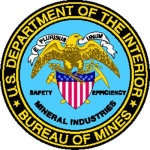- 업종: Mining
- Number of terms: 33118
- Number of blossaries: 0
- Company Profile:
The U.S. Bureau of Mines (USBM) was the primary United States Government agency conducting scientific research and disseminating information on the extraction, processing, use, and conservation of mineral resources.
Founded on May 16, 1910, through the Organic Act (Public Law 179), USBM's missions ...
A deposit of the deep sea, accumulating in depths of more than 1,500 fathoms (9,000 ft or 2.7 km) of water; these deposits comprise the organic oozes, various muds, and red clay of the deepest regions.
Industry:Mining
A deposit that is not fully consolidated under the existing overburden pressure. Not yet in equilibrium with existing physical environment. Still being compacted.
Industry:Mining
A deposit thought to have been formed at a depth ranging from 4,000 to 12,000 ft (1.2 to 3.7 km) below the surface and at a temperature between 175 degrees C and 300 degrees C. Such a deposit may take the form of a fissure vein, a series of parallel fissures called a sheeted zone, a replacement of the wall rock of fissures, or a large disseminated deposit. Much of the gold, silver, copper, lead, and zinc of the Western United States comes from these deposits.
Industry:Mining
A deposit, particularly of native copper, that occurs in basalt accompanied by minerals of the zeolite group.
Industry:Mining
A deposition of coal dust within the lungs from inhalation of sooty air.
Industry:Mining
A deposition of coal dust within the lungs from inhalation of sooty air.
Industry:Mining
A depressed region in a fault zone or between two faults, invaded by the sea. The Red Sea and Tomales Bay on the San Andreas fault in California are examples.
Industry:Mining
